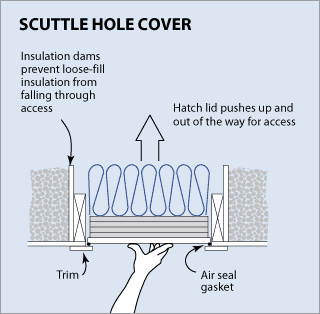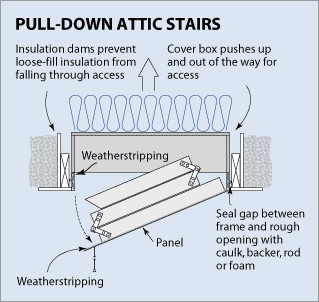attic access insulation

Energy Guard's attic hatch insulation.

Scuttle hole cover.

Pull-down stairs.
Adequately insulating and air sealing the access to an attic – especially to an unconditioned attics – will help lower your heating and cooling bills.
A home's attic access, which could be an attic hatch, pull-down stairs, or a knee-wall door, often goes uninsulated. This gap in the attic insulation increases heat loss in the winter and heat gain in the summer. These accesses also often aren't sealed properly. A 1/4-inch gap around the perimeter of an attic access can potentially leak the same amount of air supplied by a typical bedroom heating duct.
Before insulating your attic access, you should first determine the recommended insulation R-value for your area and climate.
Attic access location
If you are constructing a new home or remodeling an existing home, carefully consider the location of an attic access. The location will affect how or whether the attic access should be insulated. If possible, locate the access in an unconditioned part of the house, such as a garage, covered patio, or porch. A garage location, where the vented attic is uninsulated, can eliminate the need for air sealing and insulation.
Attic hatch
An attic hatch or scuttle hole is simply a removable portion of the ceiling that allows entry to the attic. A scuttle hole is often located in a closet or main hallway.
For air sealing, weatherstripping can be installed either on the hatch itself or on the inside of the trim or base where the hatch rests. Adding a latch bolt will help ensure a tighter seal.
After the trim or base is aligned to seal properly, insulation should be added to the attic side of the hatch. Rigid insulated sheathing is recommended. Cut the insulated sheathing 1/4 inch smaller than the hatch size to allow for clearance when moving the access panel. Apply 3 or 4 inches of insulation to the hatch with construction adhesive and screws.
As an added measure, glue the kraft-paper side of batt insulation to the top of the last layer of rigid insulation. Try to achieve the recommended R-value.
Attic pull-down stairs
When attic access is gained through pull-down stairs, the frame for the stairs fits in a rough opening and leaves a gap, much like a door or window, which must be sealed. If the gap is small (less than 1/2 inch), caulk can be used as the sealant. If a larger opening exists, then a non-expanding foam or a backing material (backer rod) is recommended in conjunction with the caulk. Expanding foam can be used, but care must be taken because of its highly expansive nature. It could potentially warp the frame and interfere with the ability of the stairs to open and close properly.
To ensure a tight fit between the stairs' flat panel and the frame, weatherstripping or gasket material should be added either to the frame or panel. Latch bolts may be installed to help ensure a tighter seal.
To insulate attic stairs access, you can construct a lightweight, moveable box from rigid foam or fibrous ductboard to fit over the stairs from the attic side. Insulating kits are also available from weatherization suppliers or local hardware.
Attic knee-wall door
A knee-wall is typically a partial height wall that is usually found in the upstairs level of finished-attic homes. These walls are notoriously leaky and often uninsulated. Knee-wall doors need to be weatherstripped. They also need a latch that pulls tightly against the weatherstripping and the frame to achieve a solid seal.
Use construction adhesive and screws to attach rigid foam insulation to the attic side of the door. Pay special attention to the clearance between the insulation and the door frame and air sealing details. Adjust insulation levels or R-values to meet those recommended for your area and climate. Also, insulate and air seal the knee walls themselves for maximum energy efficiency.
